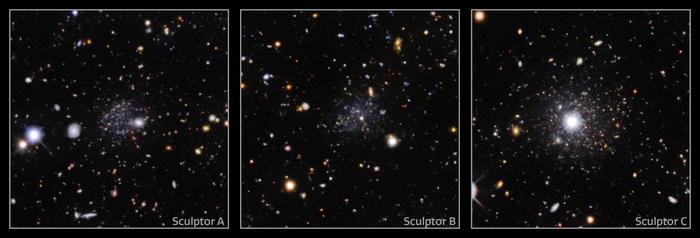Nestled in the vastness of space, three ultra-faint dwarf galaxies—Sculptor A, B, and C—have recently been discovered, capturing the attention of astronomers worldwide. Located about 6.5 million light-years from Earth, these “ghost town” galaxies are relics of the early universe. Their faint glow and isolation make them valuable for understanding cosmic history.
The Discovery of Ghost Town Galaxies
The recent identification of Sculptor A, B, and C was no easy feat. Dwarf galaxies are notoriously challenging to locate due to their faintness and small size. These galaxies contain just hundreds or thousands of stars, a stark contrast to the Milky Way’s hundreds of billions. Using data from the Dark Energy Camera (DECam) Legacy Survey, Professor Sand manually scanned images, identifying these elusive galaxies amidst the cosmic haystack.
Further observations using the Gemini South telescope confirmed the findings. The galaxies’ isolation from larger systems like the Milky Way means they provide an undisturbed glimpse into the universe’s early days, a time when the first galaxies and stars began to form.
Why Dwarf Galaxies Matter
Dwarf galaxies, though small, play a significant role in understanding the cosmos. They are thought to be some of the oldest structures in the universe, forming shortly after the Big Bang. As “time capsules,” they preserve conditions from billions of years ago, offering a direct link to the early universe.
These galaxies are also crucial for studying the cessation of star formation. Unlike active galaxies teeming with young stars, Sculptor A, B, and C are dominated by ancient stars. Their silence provides clues about why some galaxies stop forming stars altogether.
Star Formation and Its Halt
Star formation requires gas, the primary ingredient for stellar birth. However, the Sculptor galaxies lack this essential material. Theories suggest several reasons for this absence. After the Big Bang, ultraviolet photons flooded the cosmos, potentially stripping dwarf galaxies of their gas. Similarly, energetic supernova explosions could have expelled gas from these low-gravity systems.
Interestingly, the Sculptor galaxies’ isolation makes it unlikely that larger galaxies stole their gas through gravitational interactions. This points to internal processes or early cosmic events as the primary culprits behind their star formation halt.
The Scientific Significance of the Discovery
The Sculptor galaxies offer a wealth of insights into galactic evolution. By analyzing these systems, scientists can trace the universe’s transition from a chaotic, gas-filled state to one populated by structured galaxies. The ancient stars within these galaxies serve as a living record of the chemical and physical conditions of their time.
Additionally, this discovery challenges assumptions about galaxy formation. The isolated nature of the Sculptor galaxies suggests that external influences like nearby giants aren’t the sole factors in shaping galaxy evolution. Instead, internal dynamics and early cosmic events may have played a more significant role.
Dark Matter and Dwarf Galaxies
Dwarf galaxies like Sculptor A, B, and C are believed to be rich in dark matter, the mysterious substance that makes up most of the universe’s mass. Unlike ordinary matter, dark matter doesn’t emit light, making it invisible and challenging to study.
These galaxies’ low star counts and minimal visible matter make them excellent candidates for dark matter research. By analyzing their gravitational behavior, scientists can better understand how dark matter is distributed and how it influences galaxy formation.
Challenges in Detecting Ultra-Faint Dwarf Galaxies
Finding dwarf galaxies is akin to finding needles in a cosmic haystack. Their faintness and proximity to brighter systems make them difficult to identify. Advanced imaging tools like DECam and sophisticated techniques such as manual scanning and machine learning are vital for uncovering these hidden structures.
Astronomers are optimistic that future advancements in technology, including next-generation telescopes and artificial intelligence, will revolutionize the search for dwarf galaxies. These tools will enable more efficient analysis of vast datasets, potentially revealing thousands of previously hidden galaxies.
Future Directions in Dwarf Galaxy Exploration
The discovery of Sculptor A, B, and C is just the beginning. Astronomers plan to expand their search, leveraging machine learning algorithms and cutting-edge telescopes to identify more ultra-faint dwarf galaxies. These efforts will deepen our understanding of the universe’s infancy and the processes driving galactic evolution.
The insights gained from studying these galaxies could also advance our knowledge of dark matter. Understanding its role in dwarf galaxy formation may provide critical clues about its behavior and distribution across the cosmos.
Lessons from the Ghost Town Galaxies
The Sculptor galaxies teach us valuable lessons about the cosmos. Their existence underscores the diversity of galactic systems and the complex interplay of forces that shape them. They remind us that even the faintest objects can hold profound secrets about the universe’s past.
Moreover, these galaxies highlight the importance of persistence and innovation in astronomy. From manual scanning to advanced telescopes, the journey to uncover these ghost town galaxies demonstrates the power of human curiosity and technological progress.
Conclusion
The discovery of Sculptor A, B, and C marks a significant milestone in astronomy. These ultra-faint dwarf galaxies offer a rare glimpse into the early universe, serving as time capsules that preserve the conditions of a bygone era. By studying these ghost town galaxies, scientists are unraveling the mysteries of galactic evolution, star formation, and dark matter.
Reference:
‘Ghost towns’ of the universe: Ultra-faint, rare dwarf galaxies offer clues to the early cosmos



















